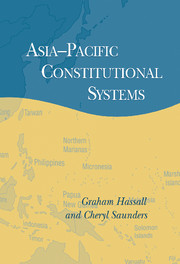Book contents
- Frontmatter
- Contents
- Acknowledgements
- Map: The Asia-Pacific Region
- Introduction
- Part I Modernity and Nation-States at the Dawn of the Global Era
- Part II The Constitution of Modernity
- Part III Democracy and the Rule of Law
- 8 Courts and the judiciary
- 9 The suspension of constitutional power
- 10 Devolution
- Conclusion: Postmodernity and constitutionalism
- Appendix: Chronology of constitutional events in the Asia Pacific
- Bibliography
- Index
9 - The suspension of constitutional power
Published online by Cambridge University Press: 09 October 2009
- Frontmatter
- Contents
- Acknowledgements
- Map: The Asia-Pacific Region
- Introduction
- Part I Modernity and Nation-States at the Dawn of the Global Era
- Part II The Constitution of Modernity
- Part III Democracy and the Rule of Law
- 8 Courts and the judiciary
- 9 The suspension of constitutional power
- 10 Devolution
- Conclusion: Postmodernity and constitutionalism
- Appendix: Chronology of constitutional events in the Asia Pacific
- Bibliography
- Index
Summary
In recent decades, a significant number of states in the Asia–Pacific region have imposed 'extraordinary security laws in times of crisis'. In some instances, emergency powers have been used to meet a crisis, then revoked when the crisis is over. In other instances, however, the crisis is over-extended or frequent use of emergency powers has provoked concern. By definition, reliance on 'emergency powers' implies suspension of normal constitutional processes, including legal protections of individual rights. The latter, in turn, often involves extended powers of arrest and interrogation to deal with terrorism and other forms of politically motivated behaviour and restrictions on freedom of movement, thought, belief, and other civil and political rights. Habeas corpus, judicial review of government action, and the normal operation of the legislature are usually suspended. The regular courts may be restricted in operation or suspended as well, in favour of the use of military or other special courts for the prosecution of what would otherwise be regarded as civil and criminal cases.
Such extensive divergence from the normal rule of law points up the paradoxical nature of emergency rule. Emergency powers theoretically are conferred for the sole purpose of protecting and preserving the constitution in times of crisis. The rights and freedoms which constitutionalism is considered to protect are suppressed under conditions of emergency. The paradox can be resolved by restricting emergency rule to the powers necessary to preserve the existence and well-being of the state, however that is identified.
- Type
- Chapter
- Information
- Asia-Pacific Constitutional Systems , pp. 198 - 221Publisher: Cambridge University PressPrint publication year: 2002



